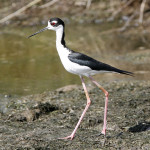• • •
Black-necked Stilts stride through shallow ponds and marshes on their spindly red legs, feeding on a variety of insects and small fish. They are a stark black on top and white on the bottom with bright red eyes. Among birds, only Flamingos have longer legs in proportion to their bodies.
• Length: 14 inches
• Wingspan: 29 inches
• Season: Year-round
More about Black-necked Stilts.
Where they are, and when.
Their diet is diverse and includes fish, crawfish, brine flies, brine shrimp, water beetles and tadpoles. They use their long needle of a bill to pick their prey from the water and mud, sometimes herding small fish in the shallows for easier hunting. They prefer walking and flying and will only rarely swim.
Black-necked Stilts often nest on small islands or clumps of vegetation in the marsh. They lay three to four olive eggs with brown speckles. When their nests are threatened by predators, they will fly up in unison and swoop down on them, or hop up and down on the ground, flapping their wings. They’ll even try the same broken-wing act you see from Killdeer.
Chicks may leave the nest within hours and are able to fly in four to six weeks.
June 9, 2012
More than a dozen Black-necked Stilts flew back and forth across the road on the far corner of Shoveler’s Pond at the Anahuac National Wildlife Refuge. Some were tending nests back among the reeds, but most appeared to be trying to create a diversion. They repeatedly flew to the grassy field on the other side and waited, probably trying to confuse predators about where they were nesting. On the road ahead, they gathered in small groups, dragging one wing on the gravel, feigning injury and creating a scene that looked like the aftermath of a roadside bomb.






You must be logged in to post a comment.